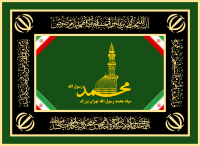27th Mohammad Rasulullah Division
This article needs additional citations for verification. (July 2016) |
27th Mohammad Rasulullah Division (Persian: لشکر ۲۷ محمد رسولالله) was a division of the Islamic Revolutionary Guard Corps Ground Forces based in Tehran.[2]
It was established as the 27th Mohammad Rasulullah Brigade by Hossein Qajeyi, Ahmad Motevasselian and Mohammad Ebrahim Hemmat during the Iran–Iraq War, and was expanded into a division just before Operation Jerusalem.
Describing the IRGC units during the Iran-Iraq war, then-commander-in-chief of IRGC Mohsen Rezaei says:[3]
We had four divisions that, anywhere they went, no [Iraqi] military force was able to resist against them. Haj Hemmat and [his] 27th Mohammad Rasulullah Division, Hossein Kharrazi and [his] 14th Imam Hossein Division, Mehdi Bakeri and [his] 31st Ashura Division, Ahmad Kazemi and [his] 8th Najaf Division—which whenever they entered, it resulted in success without exception.
Sepah-e Muhammad Rasoul Allah[edit]
The division was merged with the Basij of Tehran to form the Mohammad Rasulullah Corps of Greater Tehran during the rearrangement of the IRGC units in 2008. The Sepah-e Muhammad Rasoul Allah, the Sepah-e Sayyed al-Shohada and the Sepah-e Imam Hassan Mojtaba are controlled by the Sarallah Security Headquarters.[4]
Operational forces[edit]
The Sepah-e Muhammad Rasoul Allah performs military missions through the 27th Mechanized Infantry Operational Division. The Division is a cadre formation, consisting of four battalions. For combat operations, the 27th Division and the 10th and 23rd divisions are augmented by twenty-four Basij Imam Hussein battalions and four Sabirin quick-reaction units.[4]
Basij Imam Hussein battalions are staffed with full-time and salaried Basiji.[5][6]
Security units[edit]
The metropolitan territory of Tehran is subdivided into 23 municipalities. In each Municipality there is a Basij Resistance District:[4]
- 23 Basij Resistance Districts: each Basij Resistance District controls one Imam Ali Battalion, tasked with riot control and suppression.
- Basij Resistance Precincts: each Basij Resistance Precinct controls two all-male Beit al-Muqaddas Battalions and one all-female Kowsar Battalion. These part-time units are tasked with cultural and cyber operations, urban defense, and search-and-rescue/relief operations.
- Basij Resistance Bases: Basij Resistance Bases are scattered around neighborhoods in mosques, ministries, schools, and other sites. Within each Base, there are two all-male Ashura battalions and one all-female al-Zahra battalion. These units are tasked with cultural and cyber operations, urban defense, and search-and-rescue/relief operations but are staffed with personnel older than Beit al-Muqaddas and all-female Kowsar Battalions.
- 4 Basij Special Forces Fatehin Battalions.[7]: 8
When deployed, they answer directly to the provincial corps and operate under four citywide IRGC security units:[4]
- Valiasr;
- Hazrat-e Mojtaba;
- Imam Hadi;
- Imam Reza.
These units in turn report to Hazrat-e Zahra and All-e Muhammad brigades, attached to the Sepah-e Muhammad Rasoul Allah.
Other units[edit]
Tehran's cultural terrain is ìmonitored by Sepah-e Muhammad Rasoul Allah's "Cyberspace Cultural Operations Battalions".[4]
See also[edit]
References[edit]
- ^ Uprising shakes Iran Regime's foundations (PDF). Washington, DC: National Council of Resistance of Iran – U.S. Representative Office. pp. 39–40. ISBN 1-944942-37-8. Retrieved 22 October 2021.
- ^ "لشکری با 20 عملیات موفقیتآمیز و 4 فرمانده شهید".
- ^ سلیمانی, وحید. "شهيد احمد کاظمي، دٌر غلطان سپاه". www.tabnak.ir (in Persian). Retrieved 26 July 2019.
- ^ a b c d e Nadimi, Farzin (21 August 2017). "Murmurs of a Second Cultural Revolution". The Washington Institute. Retrieved 3 October 2021.
- ^ Golkar, Saeid (2020). TAKING BACK THE NEIGHBORHOOD The IRGC Provincial Guard's Mission to Re-Islamize Iran. WINEP.
- ^ Donovan, Marie; Carl, Nicholas; Kagan, Frederick W. (January 2020). "Iran's Reserve of Last Resort" (PDF). www.criticalthreats.org. Critical Threats. pp. 5, 6. Retrieved 19 September 2021.
- ^ Golkar, Saeid (October 2020). Protests and Regime Suppression in Post-Revolutionary Iran. Washington, USA: THE WASHINGTON INSTITUTE FOR NEAR EAST POLICY. p. 8. Retrieved 10 October 2021.


